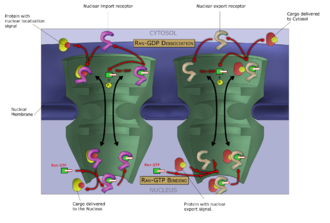Nuclear pore
| Nuclear pore | ||
|---|---|---|

|
||
| Scheme drawing | ||
| Mass / length primary structure | 120 megadaltons | |
| Transporter classification | ||
| TCDB | 9.A.14 | |
| designation | NPC family | |
| Occurrence | ||
| Parent taxon | Eukaryotes | |
| Parent |
| Cell nucleus |
| Gene Ontology |
|---|
| QuickGO |
Nuclear pores (abbreviation NPC , from English nuclear pore complex ) are protein complexes in the nuclear envelope of the cell nuclei of eukaryotic cells . The nuclear envelope consists of a double membrane . Nuclear pores go through both membranes, so they function as “gates” and allow certain molecules to be transported into and out of the cell nucleus.
There are around 2,000 pores in the nuclear envelope of a vertebrate cell.
structure
The edge of the pore consists of eight protein complexes both inside and outside. Spoke-like extensions protrude to the center of the pore, where a central granule sits, which also represents a ribonucleoprotein complex.
The pore contains a channel made up of a 3D network of FG repeats (F = phenylalanine ; G = glycine ) through which water can diffuse unhindered.

function
Nuclear pores catalyze the passive or active transport of proteins, RNA, ribonucleotide-protein complexes and small molecules across the nuclear membrane.
Passive transportation
Small molecules up to approx. 5,000 Da ( Dalton ) can diffuse freely through the core pore. Molecules of around 17,000 Da need 2 minutes to pass. Larger particles with a diameter of up to two nm or 40,000 Da cannot pass through the nuclear pores on their own.
Transport of mRNA from the nucleus
With an increased transcription rate , e.g. For example, in cells that produce many proteins, the number of nuclear pores is also increased, since although transcription occurs in the cell nucleus, translation takes place outside of the cell nucleus and every finished mRNA molecule must therefore leave the cell nucleus.
First, the protein nuclear RNA export factor 1 binds to the RNA exon junction complex (EJC). On the other hand, this aggregate binds to the export receptor of the NPC. Everything together is called the export competent complex . Movement of this complex through the pore requires energy , which is provided in the form of GTP . At the other end, the complexes mentioned dissociate again into their sub-complexes.
Import of proteins
The reverse transport of proteins into the cell nucleus only takes place if the protein has a nuclear localization sequence . This is a peptide sequence consisting of a few amino acids. Certain transport molecules ( importins ) that initiate the transport are also required .
Web links
- Michael Rout and Brian Chait explain how they resolved the structure of the nuclear pore complex , Nature Online video streaming archive
- Entry in the CORUM database
Individual evidence
- ↑ G. Joshi-Tope / reactome: Transport of Mature Transcript to Cytoplasm ( page no longer available , search in web archives ) Info: The link was automatically marked as defective. Please check the link according to the instructions and then remove this notice. - doi : 10.3180 / REACT_1281.1

